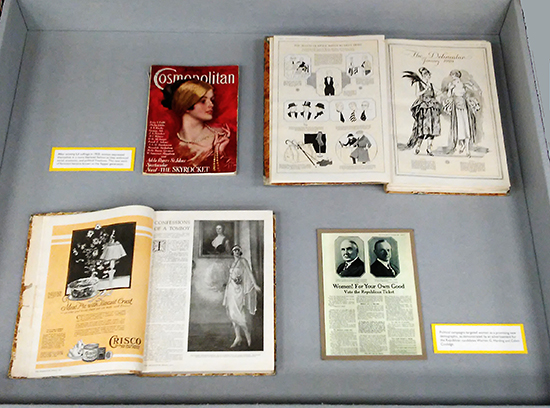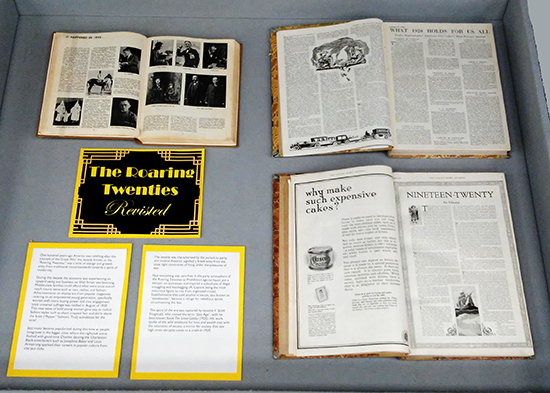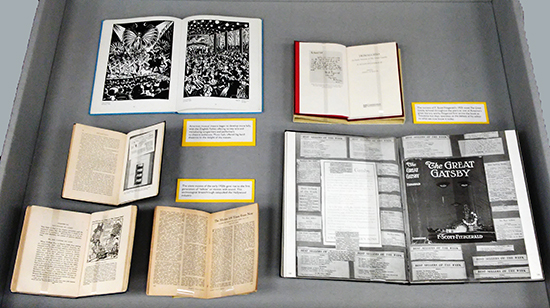January 2020
One hundred years ago America was relishing the triumph of the Great War; the decade known as the "Roaring Twenties" was a time of change and growth away from traditional moral standards towards a spirit of modernity.

During this decade the economy was experiencing an upward swing and business on Wall Street was booming. Middle-class families could afford what were once out-of-reach luxury items such as cars, radios, and fashion. Popular magazines on display catered to an empowered young generation, specifically women with more buying power and civic engagement since universal suffrage was ratified in August of 1920. This new wave of bold young women gave way to radical fashion styles such as short cropped hair and skirts above the knee ("flapper" fashion). Truly scandalous for the time!

Jazz music became popularized during this time as people integrated in the bigger cities where the nightclub scene flushed with good-time Charlies dancing the Charleston. Black entertainers such as Josephine Baker and Louis Armstrong sparked their careers in popular culture from city jazz clubs.
Not everything was care-free in the party atmosphere of the Roaring Twenties as Prohibition against liquor put a damper on businesses and inspired a subculture of illegal smuggling and bootlegging (Al Capone being the most notorious figure to rise from organized crime). Establishments that sold alcohol in secret, also known as "speakeasies", became a refuge for rebellious spirits circumventing the law.

The spirit of the era was captured by novelist F. Scott Fitzgerald, who coined the term "Jazz Age", with his best-known book The Great Gatsby (1925). This work spoke of wild ambitions for love and wealth resulted in calamities of excess; a mirror for society that saw high times abruptly come to a crash in 1929.
Ellen NicKenzie Lawson, Smugglers, bootleggers, and scofflaws: Prohibition and New York City. State University of New York Press, 2013.
NYSL Call Number: 363.41109 L425 213-2867
Michael A. Lerner, Dry Manhattan: prohibition in New York City. Harvard University Press, 2007.
NYSL Call Number: 363.41097 L616 207-6295
Kenneth D. Rose, American women and the repeal of Prohibition. New York University Press, 1996.
NYSL Call Number: 363.41 R796 96-12614
Lewis Porter,Jazz: a century of change. Schirmer Books, 1997.
NYSL Call Number: 781.65 J42 99-5526
Patricia Bayer, Art deco architecture: design, decoration, and detail from the twenties and thirties. H.N. Abrams, 1992.
NYSL Call Number: 724.6 qB357 93-45215
Arthur Edwin Krows, The talkies. Holt, [c1930]
NYSL Call Number: 778 K93
William H. Hays, See and hear. (publisher not listed), 1929
NYSL Call Number: 791.4 H42
De Witt Wallace, "The Movies 100 Years from Now" The Reader's Digest. The Reader's Digest Association, 1924.
NYSL Call Number: 051 R286 V.3 N.27-28,30-36 1924/25 UNB
R. S. O'Loughlin, "The Season of Little Things in Men's Dress" The Delineator. The Butterick Publishing Co., January 1920
NYSL Call Number: 051 fD353 V.98-108
R. S. O'Loughlin, "Women! For Your Own Good Vote the Republican Ticket" The Delineator. The Butterick Publishing Co., November 1920
NYSL Call Number: 051 fD353 V.98-108
George Ade, "Jazzmania" The Cosmopolitan. Schlicht & Field, January 1925
NYSL Call Number 051 qC8339 V.69-78
P.F. Collier & Son, "What 1920 Holds for Us All" Collier's National Weekly. January 3, 1925
NYSL Call Number: 051 fC699 V.65 P.1 1920
Robert Lockwood Mills The Lindbergh syndrome: heroes and celebrities in a new Gilded Age. Fenestra Books, c2005.
NYSL Call Number: 302.23097 M657 206-2852
F. Scott Fitzgerald, Trimalchio: an early version of The Great Gatsby. Cambridge University Press, 2000.
NYSL Call Number: 813.52 F553 202-2544
(author unlisted), "Nineteen-Twenty, an editorial" Ladies' Home Journal. Family Media Inc., January 1920
NYSL Call Number: 051 fL15h V.37 ISS. 1-7 1920
Ric Burns, New York: an illustrated history. Alfred A. Knopf, c2003.
NYSL Call Number: 974.71 qN532 99-12883
Steven Watson, The Harlem renaissance : hub of African-American culture, 1920-1930. Pantheon Books, c1995.
NYSL Call Number: 700.8996 W342 94-623
James Haskkins, The Cotton Club. New American Library, c1977.
NYSL Call Number: 974.71 qH351
Patricia Bayer Art deco architecture: design, decoration, and detail from the twenties and thirties. H.N. Abrams, 1992
NYSL Call Number: 724.6 qB357 93-45215
Elizabeth Stevenson, Babbitts and bohemians; the American 1920's. Macmillan, 1967.
NYSL Call Number: 973.9 S847
Matthew Joseph Bruccoli, The romantic egoists: [Scott and Zelda Fitzgerald]. Scribner,1974
NYSL Call Number: 813.5209 fF553 75-17183
Allan Seymour Everest, Rum across the border : the Prohibition era in northern New York 1st ed. Syracuse University Press, 1978
NYSL Call Number: 364.133 E93 79-25177
David Colbert, Eyewitness to Wall Street : 400 years of dreamers, schemers, busts, and booms 1st ed. Broadway Books, 2001
NYSL Call Number: 332.0973 C684 201-8990
Paul Sann, The lawless decade; a pictorial history of a great American transition: from the World War I armistice and prohibition to repeal and the New Deal. Crown Publishers, 1957
NYSL Call Number: 973.913 qS228
Exhibit curated by Jolana Nicotina